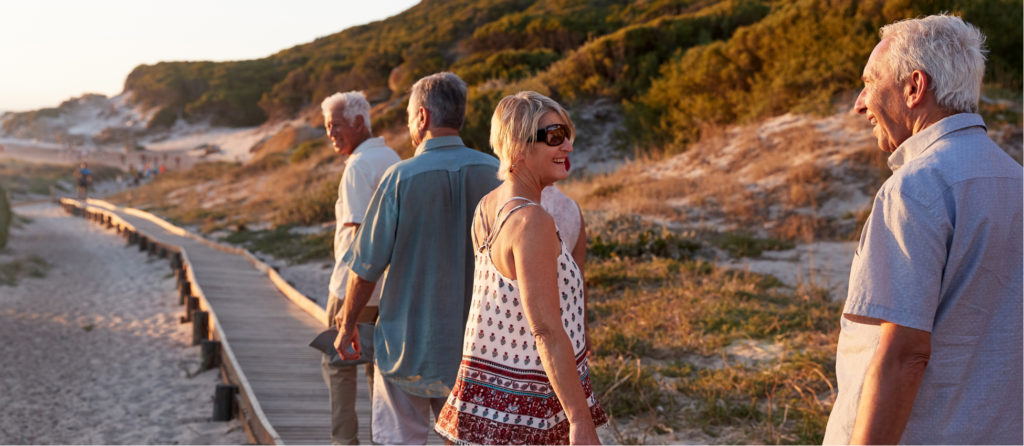Whilst visiting Ghana we had the opportunity to learn about kente cloth, the legendary eye-catching fabric worn by African kings down the centuries. At the Adanwomase Tourist Centre our guide explained that the word kente is derived from ‘kenten,’ which means ‘basket’ as it resembles the cloth’s woven design which is always made in strips, then sewn together by hand or machine.
Each design is named and has symbolic significance, and we were shown examples, with a yellow and gold zig zag on a blue background meaning the road to success was never easy with twists and turns along the way.
Having been shown the various threads used, cotton, rayon, silk, and a metallic thread, our guide demonstrated moving cotton from a skein onto a bobbin which involved turning a handle and guiding the thread. When invited to have a go, I found it surprisingly easy, with the most difficult part sitting down on the very low stool.
We were then shown how to create the warp or vertical yarn using three bobbins on a board and sticks in the ground which involved literally walking up and down the line of sticks and wrapping the yarn around them. An easy but laborious process when 400 threads are needed.
The difference between single, double, and triple weaving was outlined: the single and triple were one sided, but the double was reversible. It was then time for me to weave at the loom. A thread was placed between my toes on both feet and as I pushed down, I moved the shuttle through the warp and then damped it down twice to settle it. Again, it was relatively straightforward as the right foot and right hand worked in unison, and I didn’t need to cross co-ordinate. Once again, the most difficult part involved getting the low stool close enough to the action, and then getting up and out of the wooden contraption.
A large building was full of double weaving looms with young men weaving: the number of female weavers is less than 2% as it is physically demanding, and they concentrate on selling the fabrics. The weavers are self-employed and own their own looms but use the community space for free. Having seen how quickly they worked, their 12-hour shifts must be exhausting and tedious and not surprisingly most wore earphones. Bearing in mind the complexity of the designs, I was surprised patterns were not used.
The second part of our tour introduced us to cocoa and chocolate, and we saw cocoa pods growing on the tree trunks which are harvested when yellow. The seeds are then removed, and we were given one to suck, which had a mild chocolate flavour. They are then dried in the sun until hard and brown which removes the sugar, and this time our sample tasted more like a bitter chocolate. The seeds are then ground and used in a wide variety of goods which were shown: chocolate (40% and 90%); a natural cocoa powder without milk or sugar, which when mixed with water was said to be good for hypertension; a cocoa butter and a shea butter for dry skin; black soap and a mix of chocolate, ginger and coconut flakes. Finally, the empty cocoa shells are dried, ground and boiled with palm kernels to make soap or soup: it was often hard to differentiate between the two words due to accents.
Finally, in the fixed price shop, we bought various gifts for home including chocolate, body butters and a length of Kente cloth.
Having tried weaving, we then moved on to the village of Ntonso, the home of Adinkra cloth, famed for its symbols and proverbial wisdom. Originally it was worn only for funerals in the Ashanti Region and produced mainly in black, brown and red but now it is made in all colors and used throughout Ghana.
At the visitor centre, we were shown how the black dye is made, which involves soaking the bark of the badie tree for a day, before it is transferred to a pestle and mortar so large, two people can use it and we were both invited to have a go. The pulp is then boiled for a day in water which produces a light brown liquid, which is then strained and re-boiled several times. Each time it turns darker and thicker until it is like a black runny tar.
We were shown a poster showing the 50 most popular Adinkra symbols, although there are over 100, along with their meaning. All the ‘stamps’ looked as though they were heavy and made from metal, but we found that this was due to the black tar as they were actually light and made from Calabash with a bamboo tripod on the back for holding. We were invited to choose a coloured strip of fabric, yellow for me and red for Roy, and also three stamps. I chose one with three concentric circles called Adrinkrahene, which is King of the Adinkra symbols and a symbol for authority, leadership, and charisma. Roy chose one called Nkyinkyim with a twisting design representing the tortuous nature of life’s journey and the toughness, versatility, and dynamism required to thrive in it.
Our long strip of chosen material was laid out on foam, and having dipped the stamp in the dye, we were told to press the three stamps down hard in turn. Having finished stamping, the material was left in the sun to dry for 10 minutes whilst we browsed in the shop. Unfortunately, all the pieces were large and expensive, but at least we returned home with two lovely souvenirs of our day.







